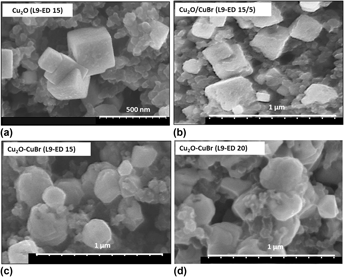Crossref Citations
This article has been cited by the following publications. This list is generated based on data provided by
Crossref.
Song, Yiming
Li, Jun
and
Wang, Chen
2018.
Modification of porphyrin/dipyridine metal complexes on the surface of TiO2 nanotubes with enhanced photocatalytic activity for photoreduction of CO2 into methanol.
Journal of Materials Research,
Vol. 33,
Issue. 17,
p.
2612.
Merino-Garcia, I
Albo, J
and
Irabien, A
2018.
Tailoring gas-phase CO2 electroreduction selectivity to hydrocarbons at Cu nanoparticles.
Nanotechnology,
Vol. 29,
Issue. 1,
p.
014001.
Duan, Huamei
Li, Yandong
Lv, Xiangyong
Chen, Dengfu
Long, Mujun
and
Wen, Liangying
2018.
CuO–ZnO anchored on APS modified activated carbon as an enhanced catalyst for methanol synthesis—The role of ZnO.
Journal of Materials Research,
Vol. 33,
Issue. 11,
p.
1625.
Merino-Garcia, Ivan
Albo, Jonathan
Solla-Gullón, Jose
Montiel, Vicente
and
Irabien, Angel
2019.
Cu oxide/ZnO-based surfaces for a selective ethylene production from gas-phase CO2 electroconversion.
Journal of CO2 Utilization,
Vol. 31,
Issue. ,
p.
135.
Brito, Juliana Ferreira de
Perini, João Angelo Lima
Perathoner, Siglinda
and
Zanoni, Maria Valnice Boldrin
2019.
Turning carbon dioxide into fuel concomitantly to the photoanode-driven process of organic pollutant degradation by photoelectrocatalysis.
Electrochimica Acta,
Vol. 306,
Issue. ,
p.
277.
Weng, Lien-Chun
Bell, Alexis T.
and
Weber, Adam Z.
2019.
Towards membrane-electrode assembly systems for CO2 reduction: a modeling study.
Energy & Environmental Science,
Vol. 12,
Issue. 6,
p.
1950.
Puppin, Lara G.
Khalid, Mohd.
da Silva, Gelson T.T.
Ribeiro, Caue
Varela, Hamilton
and
Lopes, Osmando F.
2020.
Electrochemical reduction of CO2 to formic acid on Bi2O2CO3/carbon fiber electrodes.
Journal of Materials Research,
Vol. 35,
Issue. 3,
p.
272.
Farid, Muhammad Asim
Ijaz, Sana
Ashiq, Muhammad Naeem
Ehsan, Muhammad Fahad
Gul, Fiza
Batool, Syeda Rabia
Athar, Muhammad
and
ul Hassan, Sadaf
2022.
Synthesis of mesoporous zirconium manganese mixed metal oxide nanowires for photocatalytic reduction of CO2.
Journal of Materials Research,
Vol. 37,
Issue. 2,
p.
522.
Ge, Lei
Rabiee, Hesamoddin
Li, Mengran
Subramanian, Siddhartha
Zheng, Yao
Lee, Joong Hee
Burdyny, Thomas
and
Wang, Hao
2022.
Electrochemical CO2 reduction in membrane-electrode assemblies.
Chem,
Vol. 8,
Issue. 3,
p.
663.
Lee, Taemin
Lee, Yujin
Eo, Jungsu
and
Nam, Dae-Hyun
2024.
Acidic CO2 electroreduction for high CO2 utilization: catalysts, electrodes, and electrolyzers.
Nanoscale,
Vol. 16,
Issue. 5,
p.
2235.
Staerz, Anna F.
van Leeuwen, Marieke
Priamushko, Tatiana
Saatkamp, Torben
Endrődi, Balázs
Plankensteiner, Nina
Jobbagy, Matias
Pahlavan, Sohrab
Blom, Martijn J. W.
Janáky, Csaba
Cherevko, Serhiy
and
Vereecken, Philippe M.
2024.
Einfluss von Eisenionen auf die Niedertemperatur CO2 Elektrolyse.
Angewandte Chemie,
Vol. 136,
Issue. 5,
Staerz, Anna F.
van Leeuwen, Marieke
Priamushko, Tatiana
Saatkamp, Torben
Endrődi, Balázs
Plankensteiner, Nina
Jobbagy, Matias
Pahlavan, Sohrab
Blom, Martijn J. W.
Janáky, Csaba
Cherevko, Serhiy
and
Vereecken, Philippe M.
2024.
Effects of Iron Species on Low Temperature CO2 Electrolyzers.
Angewandte Chemie International Edition,
Vol. 63,
Issue. 5,
Medina, Marina
Carvalho, Vinícius José
da Silva, Leanderson Araujo
Borges, Gabriel Gonçalves
Capelupi, Thiago
Piani, Arthur
Mauriz, Pedro Paes
Gomes, João Vitor
and
de Brito, Juliana Ferreira
2025.
Electrocatalytic contributions from Brazilian research groups for clean energy conversion and environmental remediation.
Journal of Solid State Electrochemistry,
Vol. 29,
Issue. 3,
p.
795.
